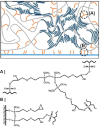Semiconducting Polymers for Neural Applications
- PMID: 35089012
- PMCID: PMC9007464
- DOI: 10.1021/acs.chemrev.1c00685
Semiconducting Polymers for Neural Applications
Abstract
Electronically interfacing with the nervous system for the purposes of health diagnostics and therapy, sports performance monitoring, or device control has been a subject of intense academic and industrial research for decades. This trend has only increased in recent years, with numerous high-profile research initiatives and commercial endeavors. An important research theme has emerged as a result, which is the incorporation of semiconducting polymers in various devices that communicate with the nervous system─from wearable brain-monitoring caps to penetrating implantable microelectrodes. This has been driven by the potential of this broad class of materials to improve the electrical and mechanical properties of the tissue-device interface, along with possibilities for increased biocompatibility. In this review we first begin with a tutorial on neural interfacing, by reviewing the basics of nervous system function, device physics, and neuroelectrophysiological techniques and their demands, and finally we give a brief perspective on how material improvements can address current deficiencies in this system. The second part is a detailed review of past work on semiconducting polymers, covering electrical properties, structure, synthesis, and processing.
Conflict of interest statement
The authors declare no competing financial interest.
Figures




























References
Publication types
MeSH terms
Substances
LinkOut - more resources
Full Text Sources
Miscellaneous

